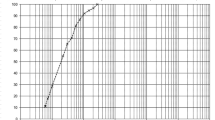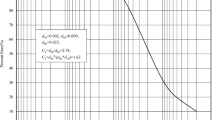Abstract
Knowledge of current conservation materials and methods together with those adopted in the past is essential to aid research and improve or develop better conservation options. The infill and painting of tile lacunae are subjected to special requirements mainly when used in outdoor settings. A selection of the most commonly used materials was undertaken and performed based on inquiries to practitioners working in the field. The infill pastes comprised organic (epoxy, polyester), inorganic (slaked lime, hydraulic lime and zinc hydroxychloride) and mixed organic–inorganic (slaked lime mixed with a vinylic resin) binders. The selected aggregates were those most commonly used or those already present in the commercially formulated products. The infill pastes were characterised by SEM, MIP, open porosity, water absorption by capillarity, water vapour permeability, thermal and hydric expansibilities and adhesion to the ceramic body. Their performance was assessed after curing, artificial ageing (salt ageing and UV–Temp–RH cycles) and natural ageing. The results were interpreted in terms of their significance as indicators of effectiveness, compatibility and durability.















Similar content being viewed by others
References
J. Griswold, S. Uricheck, J. Am. Inst. Conserv. 37(1), 89–110 (1998)
L. Durbin, Architectural tiles: Conservation and Restoration: From the Medieval Period to the Twentieth Century. (Butterworth–Heinemann, 2005), pp. 129–132
J. Thornton, J. Am. Inst. Conserv. 37(1), 3–22 (1998)
S.P. Koob, J. Am. Inst. Conserv. 37(1), 49–67 (1998)
C. Torney, A. Forster, C. Kennedy, E. Hyslop, Struc. Surv. 30, 297–311 (2012)
B. Moliner, M. Perez, La Conservación y Restauración de la Azulejería. (Universidad Politécnica de Valencia, 2006)
A. Morales, La Cerámica Arquitectónica: Su conservación y restauración. (Universidad de Sevilla, 2007), pp. 167–176
L. Ruffinelli, Azulejos – Storia Tecnica e Conservazione. Master thesis, Università degli Studi di Urbino, 2007
M. Perez, Investigación y análisis de las masillas de relleno para reintegración de lagunas cerámicas arqueológicas. Tesis Doctoral, Universidad Politécnica de Valencia, 2007
M.T. Mendes, T. Ferreira, S. Pereira, L. Esteves, J. Mirão, J. Mimoso, A. Candeias, Conservation treatments of azulejo: materials for volumetric reintegration, in Proceedings of AZULEJAR2012 – Conservação de Revestimentos Azulejares em Fachadas, Editor: A. Velosa, Aveiro, Outubro, 2012, ISBN:978-989-98041-1-1
C. Bennardo, P. Meli, G. Biscontin, N. Berlucchi, R. Corradini, F. Mattolin, Comparative study of different methods for gap filling applications and use of adhesives on the biocalcarenite surfaces of the “Tempio della Concordia” in Agrigento, in Proceedings of the 9th International Congress on Deterioration and Conservation of Stone, 2000
E. Nagy, J. Am. Inst. Conserv. 37(1), 69–87 (1998)
B. Szemerey-Kiss, A. Torok, Environ. Earth Sci. 63, 1613–1621 (2011)
N.H. Tennent, L. Calcutt, T.P. Oliveira, M.W. Overhoff, S.R.M. Pereira, K.E. Lookeren-Campagne, The evaluation of zinc hydroxychloride cement pastes for the conservation of damaged tiles, in ed. by J. Bridgland ICOMCC 17th Triennial Conference Preprints, Melbourne, 15–19 September 2014, art. 0503, 7 pp. International Council of Museums, Paris
M. T. Mendes, S. Pereira, T. Ferreira, J. Mirão, A. Candeias, Int. J. Conserv. Sci. 6(1), 51–62 (2015)
J. Musacchi, Conservation of historic Portuguese tile: adhesives for outdoor exposure. Master thesis, Bologna University, 2012
L. Nunes, Uncertainty of tests and measurements in a testing laboratory of natural stones, Relatório LNEC 313/05 NCMC, (LNEC, 2005)
S. Pereira, J-M Mimoso, A. Santos-Silva, Physical-chemical characterization of historic Portuguese tiles, Relatório LNEC 23/2011, (LNEC, 2011)
http://www.wacker.com/cms/en/products/product/product.jsp?product=9617. Accessed 07 July 2015
M. R. Veiga, J. Aguiar, A. Santos Silva, F. Carvalho, Methodologies for characterisation and repair of mortars of ancient buildings, in Proceedings of International Seminar Historical Constructions 2001. Guimarães, Universidade do Minho, November 2001
A. Isebaert, L.Van Parys, V. Cnudde, Constr. Build. Mater. 59, 39–50 (2014)
Acknowledgments
The authors acknowledge Fundação para a Ciência e Tecnologia for PhD Grant (SFRH/BD/65824/2009) and financial support for the execution of this work (Project CerAzul: PTDC/CTM-CER/119085/2010). CNS-Comércio de Tintas, Lda., is thanked for supplying the Airocoll S and Nova Terracota SA for providing the ceramic biscuits. Rosario Veiga and Sandro Botas are thanked for the usage of the natural ageing facilities and wall adhesion mortar, respectively. Dória Costa and Inês Cardoso for support on the thermal and hydric expansibilities and SEM analysis.
Author information
Authors and Affiliations
Corresponding author
Rights and permissions
About this article
Cite this article
Mendes, M.T., Esteves, L., Ferreira, T.A. et al. Lacunae infills for in situ treatment of historic glazed tiles. Appl. Phys. A 122, 547 (2016). https://doi.org/10.1007/s00339-016-0053-4
Received:
Accepted:
Published:
DOI: https://doi.org/10.1007/s00339-016-0053-4




